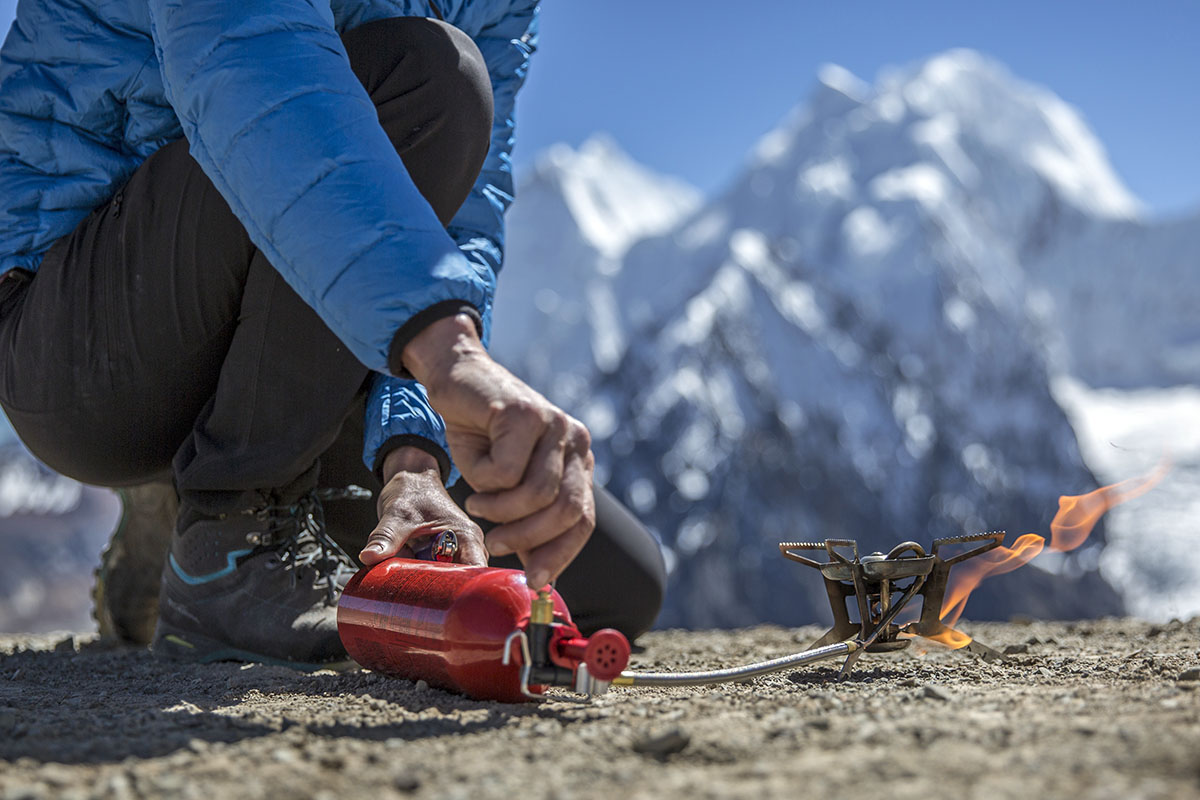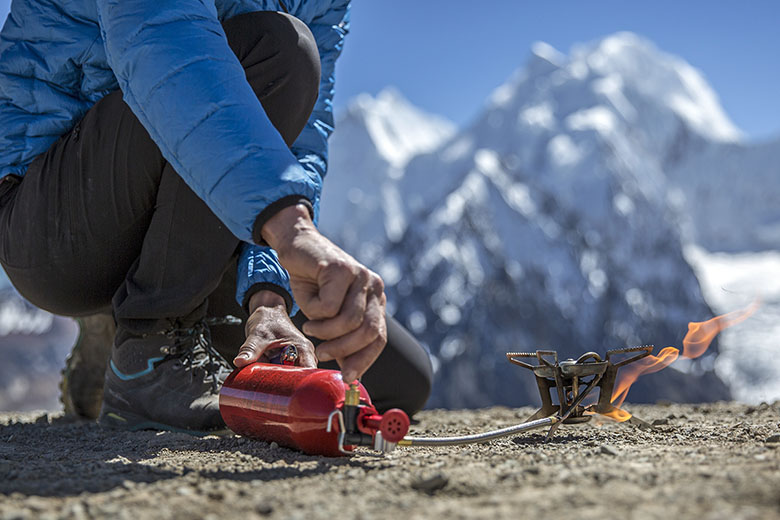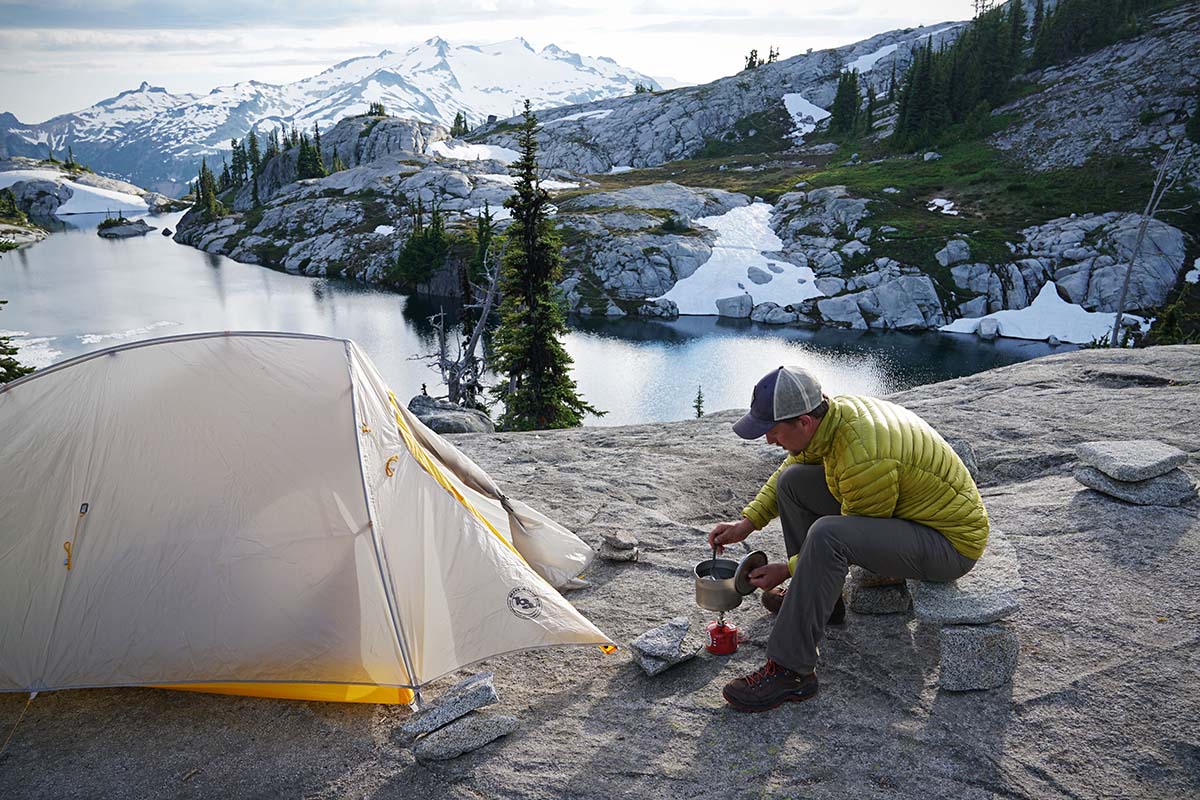

If you’re heading into the backcountry overnight and plan to eat more than just granola and energy bars, you’re going to need a way to heat your food. A backpacking stove is a necessity for any backpacker or beyond-the-car-camper, and the good news is that modern models are lighter, more compact, and more efficient than ever. Below we outline all the information you need to know in order to choose the right backpacking stove for you, from fuel types to integrated vs. non-integrated stoves, simmering capabilities, weight, and more. For a look at our top picks, check out our article on the best backpacking stoves.
The first thing you need to ask yourself when looking for a backpacking stove is what type of meals you plan to cook. If you’ll be exclusively boiling water for coffee or dehydrated food, look for a simple unit with a fast boil time, like the Jetboil Flash. If you're more of a gourmet camp chef, sizzling up bacon and hash browns for breakfast, you’ll likely need a model with interchangeable cookware and simmering capabilities (the MSR DragonFly is one of our favorites).

There are five main fuel types when it comes to backpacking stoves: canister, liquid fuel, alcohol, wood-burning, and solid tablets. These latter three options are also known as alternative fuels. Most backpackers will opt for the ease and efficiency of canister or liquid fuel-powered stoves, but some will appreciate the weight savings of alternative options. Below we detail the pros and cons of each style.
Canister stoves tend to be the most popular type among backpackers for their efficiency, ease of use, and packability. Fuel canisters (generally available in 4-, 8-, and 16-ounce capacities) come preloaded with a pressurized mix of isobutane and propane. To use, simply screw the canister onto the stove, open the valve, and light the burner (some canister stoves even come with a built-in igniter). Simple as that. Canister stoves burn very clean and are the most effective option for boiling water (the Jetboil Flash, for example, boils a liter in around 3.5 minutes), and some are capable of simmering as well. Further, they’re generally lighter and more compact than liquid fuel stoves. For backpackers looking to maximize space and efficiency, the canister stove is a great choice.
.jpg)
There are some drawbacks, however. For one, canisters are a bit bulky and heavy, which is burdensome if you need to carry a lot of fuel for extended trips. Further, it’s difficult to refill and recycle canisters, which can result in a great deal of waste. Additionally, isobutane stops vaporizing in freezing temperatures, and canister stoves struggle to maintain pressure at altitude (more on these issues below). Finally, you cannot fly with canisters, and in our experience, finding them while traveling abroad can be a bit of a wild goose chase.
.jpg)
Canister stoves are perhaps the most popular option among backpackers, but liquid and multi-fuel stoves certainly have their place. These models are accompanied by a refillable fuel bottle, which connects to the stove via a fuel line. All liquid stoves run on white gas, which is a highly refined, clean, and hot-burning fuel that can be purchased at most outdoor and hardware stores (and is less expensive per ounce than canister fuel). Some liquid fuel stoves—like the MSR WhisperLite International—can burn a multitude of fuel types, including kerosene and unleaded gasoline.
For this reason, liquid and multi-fuel stoves are ideal for overseas travel, as you’ll be able to find an appropriate fuel source most places in the world (that said, white gas is always the most efficient and cleanest-burning option). Liquid fuel also performs better in cold temperatures and at altitude than isobutane/propane, and white gas burns hotter too. Further, white gas is a far better choice for longer trips, as you can bring more with less bulk and even store your backup supply in a lightweight plastic bottle (just don’t mistake it for water!). But perhaps our favorite benefit is the way that it cuts down on waste—you can purchase liquid fuel in bulk and reuse the same fuel bottle over and over again. In sum, if you'll be traveling abroad, backpacking for extended periods of time, or cooking in cold climates, liquid fuel is a great choice.
.jpg)
The downside to liquid fuel stoves is that they generally are heavier, bulkier, more expensive, and slower than their canister counterparts—not to mention many of them are not able to simmer. Further, they’re more complicated to use: most liquid-fuel stoves require priming (burning a few drops of fuel in a cup to preheat the fuel line) and need to be pumped every few minutes while cooking to maintain pressure. And lastly, liquid fuel stoves require more cleaning and maintenance than canister stoves, as there are more moving parts.
If you’re looking for something different, it might be worth considering an alcohol, wood-burning, or solid fuel tablet stove. On the whole, these stoves are simple, lightweight, and inexpensive, making them popular among minimalists and ultralight enthusiasts. Alcohol stoves burn denatured alcohol (which can be found almost anywhere) and—in their most basic form—can be made by punching holes along the rim of a tuna fish or cut-off soda can. Solid fuel tablet stoves (like the Esbit Pocket Stove) run off of lightweight tablets that burn for around 12 minutes each. Finally, wood-burning stoves (such as the 4.1-ounce Vargo Titanium Hexagon Wood Stove) are fueled by biomass—sticks, twigs, bark, grass—which means you won’t have to pack fuel along with you.
.jpg)
Because they utilize very lightweight (or in situ) fuel, alternative-fuel stoves are ideal for extended backpacking trips with few resupply opportunities along the way. However, they simply cannot match the efficiency, heat output, boil times, or flame control of liquid fuel or canister stoves. Further, in wet climates, it can be very difficult to get these stoves burning, and the flame needs constant attention to be maintained. And lastly, alternative fuel options are prohibited in some areas. For example, Rocky Mountain National Park has banned all alcohol, solid fuel tablet, and wood-burning stoves due to their lack of a shut-off valve. However, in the right situation, the light weight and simple design of alternative fuel stoves can be a great match for ultralight backpackers.
.jpg)
If you opt for a canister stove, your next decision is between an integrated and non-integrated setup. An integrated stove is an all-in-one system that consists of a burner, heat exchanger, and a pot (such as the Jetboil MicroMo), whereas a non-integrated stove is a separate system from the cookset (like the MSR PocketRocket 2). In general, we love integrated stoves for boiling water (great for dehydrated meals), but non-integrated stoves offer more versatility for cooking (ideal for the gourmet camp chef).
Integrated models are without question the most efficient canister stoves, as their tight and thoughtful designs transfer heat effectively and keep wind out. As a result, they have far and away the fastest boil times of any other style of stove on the market. However, integrated units are often bulkier, heavier, and more expensive than non-integrated stoves (but remember that features like the windscreen and cookset won’t have to be purchased and packed separately). Further, they generally are mostly limited to boiling water, are rarely compatible with other pots and pans, and lack simmering capabilities. However, there are notable exceptions to this rule, such as Jetboil’s MiniMo, which has great simmering capabilities and can pair with Jetboil’s Pot Support to accommodate various cookware.
.jpg)
Non-integrated stoves, on the other hand, offer a significant amount of versatility by being able to pair with a variety pots and pans, and generally have better flame control. They also tend to be less expensive, lighter, and more packable than integrated systems (but again, keep in mind you’ll need a cookset as well). The MSR PocketRocket Deluxe is one of our favorite non-integrated options, with great flame control, a stable base, and wide burner head to support whatever you set on top. The downsides of non-integrated stoves are that they’re more exposed to the elements (it’s a good idea to cook with a windscreen) and are not as efficient or convenient to use. However, these drawbacks are well worth it for ounce-counting minimalists or backcountry chefs looking for the most versatility in their cook system.
If your backcountry meal goals involve actually cooking your food (rather than just adding water to a dehydrated meal), you’ll want to look for a stove with simmering capabilities. All canister and liquid fuel stoves will have dials to turn the flame on and off, but only some of these offer effective flame control. For example, the Jetboil Flash works well at full power but isn’t able to run on low. The MSR DragonFly, on the other hand, offers great flame control that allows you to cook more complex meals. Most alternative fuel stoves lack simmering capabilities altogether (a key exception is the Trangia Spirit Burner) or require a great deal of care to control the flame (as in the case of a wood-burning stove).
.jpg)
When shopping for a backpacking stove, a common spec you'll see regarding heat output is boil time. Typically, the boil time will indicate how long the stove takes to boil 1 liter of water, although this metric is not always consistent (for example, the AntiGravityGear Tin Man Aluminum Can Alcohol Stove’s advertised boil time is for two cups of water). The fastest boil time on the market is the Jetboil Flash, which boils 1 liter of water in 3.5 minutes. On the other end of the spectrum, alternative fuel stoves may take anywhere from 10 to 15 minutes to boil the same amount. The Flash’s boil time is impressive, but remember that it’s an integrated stove system with no simmer capabilities (i.e., it does one thing, and does it well).
As with all backpacking gear, the weight and packability of your cooking setup is a key factor to consider. But the weight and packability of your camp kitchen can be a little bit more complicated to determine than other pieces of gear, considering all the moving pieces. As you consider stove weight, make sure you’re also factoring in what sort of meals you’ll be cooking, the amount of fuel necessary to last you the trip, and whether or not you need to add a cookset (and how much it weighs).
.jpg)
With that in mind, generally speaking, alternative fuel stoves will be the lightest options given their unique builds and fuel sources (with wood-burning stoves, you collect your fuel in the field). But even at the heavy end of the spectrum, stoves like the canister-based MSR Reactor still clock in at less than a pound (in this case, 14.7 oz.), and the efficiency and reliability are far superior to alternative options. For those looking for a middle ground, we recommend a stove like the Snow Peak LiteMax, which is powerful and efficient but weighs in at an extremely low 2 ounces (although keep in mind that you’ll have to add the weight of a canister and pot).
As mentioned above, cooking in cold climates and at altitude are important considerations when shopping for a backpacking stove. The isobutane in canister stoves can stop vaporizing in freezing temperatures, which inhibits the fuel from feeding the flame. Similarly, canisters can depressurize at altitude, which results in a weak or nonexistent flame. Some non-integrated canister stoves (like the MSR WindPro II) are built so that the canister inverts, which circumvents these issues and allows for liquid fuel to flow directly to the stove. In these conditions, however, liquid and multi-fuel stoves typically are your best bet. Because they are pressurized with a hand pump, they maintain their efficacy in cold conditions and at high elevations.
.jpg)
For those traveling internationally, it’s important to note that you cannot fly with canisters, and they can be difficult to track down in some corners of the world (especially areas that aren’t known for outdoor tourism). As a result, liquid and multi-fuel stoves again win out—white gas is slightly easier to find, and unleaded gasoline is available everywhere there are vehicles (keep in mind that you’ll need a multi-fuel stove in order to use unleaded gasoline, such as the aptly named MSR WhisperLite International). Alternative fuel stoves are also viable options if you plan on backpacking abroad.
The price point on backpacking stoves varies widely, from premium $200+ models to simple, no-frills units like the $14 Etekcity Ultralight. Much like weight and packability though, the cost of a backpacking stove isn’t cut-and-dry. For non-integrated systems, you’ll need to take into account that you’ll be purchasing a cookset separately. Additionally, the cost of fuel is an important factor, with white gas being more affordable than canisters, and available in bulk too. Alternative fuel stoves are generally the least expensive options, but they’re also less effective and more difficult to use overall. One of our favorite budget stoves that puts it all together is the MSR PocketRocket 2, a lightweight canister stove with simmer control for just $45.
.jpg)
That's a great question. There are a ton of backcountry meals options on the market to choose from, including everything from just-add-water options to breakfasts and dinners that require cooking over a flame. With a little ingenuity, you can put together your own meals too (and probably save some money in the process). Deciding on what backpacking food is right for you can come down to a number of factors, including price, weight, nutritional value, taste, and more. For detailed recommendations and information, check out our guide to the best backpacking meals.
.jpg)
Over the years, we’ve tested a wide range of backpacking stoves in a variety of environments. Our best backpacking stoves article puts together our top picks, which run the gamut from efficient canister and liquid fuel options to minimalist stoves powered by alternative fuel sources. Below are a few of our favorites broken down into a few key categories:
Best Overall Backpacking Stove: Jetboil Flash Cooking System
Best Ultralight Backpacking Stove: MSR PocketRocket 2
Best Stove for 4-Season Backpacking: MSR WhisperLite Universal
Best Alcohol Stove for Backpacking: AntiGravityGear Tin Man Stove
See Our Top Backpacking Stove Picks